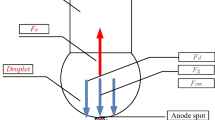Abstract
This paper presents a method for automatic control of arc length in tungsten inert gas (TIG) welding process using the arc voltage. By using this method, the role of operator in arc length control is played by an automatic control system based on a predefined arc voltage value for any special welding operation. A dynamic model for feed-rate mechanism and the relation between variations of arc length and voltage are described in details. Using a proportional-integral controller, variations of arc length in welding path is compensated with an automatic feed-rate mechanism in a normal direction to the welding path. By keeping the voltage constant during the process, a stable weld with higher quality and better appearance is obtained specially in welding of uneven surfaces. Theoretical and practical investigations show that the suggested method is able to control the TIG welding process successfully. Test results show that an accurate weld is obtained without the interference of the operator, and by comparing the predefined values of arc voltage with what is practically obtained, the welding gap is automatically adjusted.
Similar content being viewed by others
References
Yi X, Shan P, Hu S, Luo Z (2002) A numerical model of wire melting rate in CO2 gas-shielded welding. Mater Des 23:501–504
Li YC, Ushio M, Tanaka M (2000) Effect of surface active flux on welding-pool depth and arc phenomena in TIG welding. Chinese J Mech Eng 36(12):43–44
Grosdidier T, Liao HL, Tidu A (2000) Proceedings of NTSC 2000, p 1341
Zhang YM, Liguo E, Walcott BL (1998) Interval model based control of Gas metal arc welding. IEEE International Conference, American Control Conference 3:1752–1756
Narita K, Takagi K, Kimura T, Mitsui A (1975) Automatic welding of pipeline in Japan: part 1—some experiences with site applications. Int J Press Vessels Piping 3(3):175–194
Tsai C-H, Houb K-H, Chuanga H-T (2006) Fuzzy control of pulsed GTA welds by using real-time root bead image feedback. J Mater Process Technol 176:158–167
Li Z, Wang B, Ding J (2009) Detection of GTA welding quality and disturbance factors with spectral signal of arc light. J Mater Process Technol 209:4867–4873. doi:10.1016/j.jmatprotec.2009.01.010
Mirapeix J, Garciá-Allende PB, Cobo A, Conde OM, Lopez-Higuera JM (2007) Real-time arc-welding defect detection and classification with principal component analysis and artificial neural networks. NDT&E International 40:315–323
Mishra S, Lienert TJ, Johnson MQ, DebRoy T (2008) An experimental and theoretical study of gas tungsten arc welding of stainless steel plates with different sulfur concentrations. Acta Mater 56:2133–2146
Lindgren L-E (2006) Numerical modeling of welding. Comput Methods Appl Mech Engrg 195:6710–6736
Zhang G-J, Leng X-S, Wu L (2006) Physics characteristic of coupling arc of twin-tungsten TIG welding. Trans Nonferrous Met SOC China 16:813–817
Zhang H, Zhanga G, Caib C, Gaoa H, Wua L (2008) Fundamental studies on in-process controlling angular distortion in asymmetrical double-sided double arc welding. J Mater Process Technol 205:214–223
Gilles P, El-Ahmar W, Jullien J-F (2009) Robustness analyses of numerical simulation of fusion welding NeT-TG1 application: “single weld-bead-on-plate”. Int J Press Vessels Piping 86:3–12
Bose BK (1985) Sliding mode control of induction motor. IEEE/IAS Conference Record 479–486
Utkin VI (1993) Sliding mode control design principles and applications to electric devices. IEEE Trans Ind Electron 40(1):23–36
Institute of Welding (1962) Physics of the welding arc, a symposium. Institute of Welding, London
The Welding Institute (1979) Arc physics and weld pool behavior, an international conference. The Welding Institute, London
Bose BK (1986) Power electronics and AC drives. Prentice-Hall, Englewood Cliffs
Chu W-H, Tung P-C (2005) Development of an automatic arc welding system using a sliding mode control. Int J Mach Tool Manuf 45:933–939
Ferjutz K, Davis JR (1993) ASM handbook, volume 6: welding, brazing, and soldering. ASM International, Materials Park, 10 editions, ISBN-10: 0871703823
Author information
Authors and Affiliations
Corresponding author
Rights and permissions
About this article
Cite this article
Karafi, M.R., Narimani, R., Hojjat, Y. et al. Study on automatic control of arc gap in robotic TIG welding. Int J Adv Manuf Technol 50, 953–960 (2010). https://doi.org/10.1007/s00170-010-2564-z
Received:
Accepted:
Published:
Issue Date:
DOI: https://doi.org/10.1007/s00170-010-2564-z




